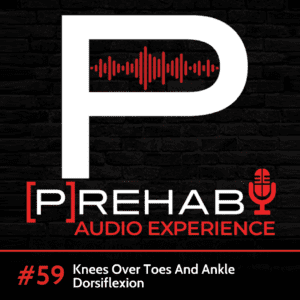
We’ve all been there before, rehab is going really well for your patient and every session builds off the previous, you’re happy and your patient is happy! You find yourself progressing every single movement and increasing the challenge because your rationale is the patient is getting better so why not push the limits? Next thing you know reality checks in and your patient has experienced a setback with increased pain, decreased load tolerance, and reports of stiffness with greater ranges of motion.“I think we overdid it doc…I guess my ankle isn’t ready still” What went wrong?! How are you even supposed to know that could happen? Was it the exercise, was it too much too soon, what did my patient do that they’re not telling me!? Let’s take you through a systematic approach for lateral ankle sprain rehab.
“This blog is one of our ‘clinical pearls’, which is designed to assist clinicians in understanding exercise progressions for various clinical conditions. Throughout each of these clinical pearls, you will learn multiple ways to attack similar issues we all see when treating our patients. We also highlight many of our personal exercise library videos throughout these pearls, all of which you can gain access to as an exercise library member!”
Progressing Optimally Through Lateral Ankle Rehab
Valid questions indeed, our goal is to help shed light on some potential answers. In this post, we will refer to three different phases of ankle sprain rehab & education that you can find in [P]Rehab Exercise Library. Also, what are the necessary considerations you have to think about as a clinician when choosing an exercise or an intervention for a lateral ankle sprain, but more importantly, how do you safely progress your patient dealing with this injury?
Are You Looking For More Of These Exercises You Can Prescribe For Your Patients?

Lateral Ankle Sprain Etiology
A lateral ankle sprain refers to a ligament injury of either the anterior talofibular and/or posterior talofibular ligament and/or the calcaneofibular ligament. These ligaments collectively provide stability to the lateral aspect of the ankle. It is much easier to sprain the lateral ankle ligaments versus the medial ankle ligaments or the structures involved in high ankle sprains because of the common mechanism of injury (rolling the ankle) and the lateral ligaments are simply inferior in comparison when it comes to their quantity and design. Up to 70% of the general population have or will experience a lateral ankle sprain in their lifetime, that’s crazy! What is even scarier is how high the reinjury rate is for lateral ankle sprains, especially within the first year (two-fold reinjury risk) making it the highest reinjury rate among all lower body injuries. As clinicians, it is our job to change the narrative and decrease this extremely high reinjury rate!
Before Discussing Exercise Progressions: CYA & Rule Out A Fracture
Not all that common, but foot & ankle fractures can and do happen with ankle sprains. It is extremely important you rule out a fracture or refer out if you suspect a fracture to do no harm to your patients. Below is a great video Mike put together to refresh you on the Ottawa Ankle Rules, but the video and the short description below should do the trick!
-
- Can your patient take 4 steps (it’s okay if they need to limp)? NO? –> REFER FOR IMAGING
- Do you have tenderness/pain around your medial or lateral malleoli (the little bone bumps on either side of your ankle)? Specifically the backside of the bones? YES? –> REFER FOR IMAGING
- Do you have tenderness/pain around the base of the 5th metatarsal (bump on the lateral/outside portion of your foot; halfway between your heel and your little toe)? YES? –> REFER FOR IMAGING
- Do you have tenderness/pain around the navicular bone (bump on the medial/inside portion of your foot?) YES –> REFER FOR IMAGING
Phase 1: Acute Lateral Ankle Sprain Management – Put The Fire Out
We will consider phase 1 as our acute phase (day 0 to day 14). This is where our role as educators & guiders is so important. If you’re not car savvy and your car breaks down, the red alert signal goes off in your brain and you scramble to get assistance. When you’re seeking that assistance, you’re really looking for answers that will reassure you everything is going to be ok so that your brain no longer sounds the alarm. Well guess what, this is what happens to the average person who is not savvy with the human body and physical rehab! That’s why I like to say put the fire out, calm things down not only physically, which we will get into in a moment, but calm things down mentally and get patient buy-in. Trust is essential for the healing process!
READ: UNDERSTANDING TISSUE HEALING AFTER INJURY
Lateral Ankle Sprain Education: How To Break It Down For Your Patients
Let’s face it, most patients want to know what happened and how bad the injury is (as clinicians we do the same thing don’t lie to yourself!). Below are some great education pieces you can use a refresher if you like telling your patients, but you can also include these in your patient’s program in case they tend to forget and ask the same questions :)
Understanding Ligament Sprains
Being able to confidently define and break down the differences between ligament sprains versus other injuries such as muscle strains can go a long way and will make your patients trust you!
Understanding Lateral Ankle Sprain Grades
Remember most ankle ligament injuries are classified into three grades representing increasing severity.
- Grade I = mild ankle sprain, 2-4 week recovery
- Grade II = moderate ankle sprain, 1-2 month recovery
- Grade III = severe ankle sprain; full ligament tear, 3+ month recovery
Therapeutic Exercises Are Better Than RICE!
The old adage of Rest, Ice, Compression, and Elevation (RICE) for ankle sprain rehab is far outdated. Complete rest is one of the worst things you can do following an ankle sprain, and instead, P.O.L.I.C.E is now the recommendation. Rest is replaced by Protection, and Optimal Loading. This means that early on, we need to protect the injured areas by not over-stressing the tissues, but still applying healthy submaximal loads to the tissues that actually stimulate the healing process, which we will chat about in a bit!
Ankle Pump – Elevated
Furthermore, recent research has shown that the individual elements of RICE alone are not effective, apart from icing immediately after the injury for the first few days, if given along with exercise. This means that the most important part of ankle sprain rehab is providing protection and optimal loading through exercise, not the rest/icing/compression/elevation that is typically recommended! We know elevation can still be beneficial though, that’s why we like to program ankle pumps elevated but also seated ankle pumps if people have to go back to their sitting job, constant motion is key! That is why we also like to program the gentle range of motion exercises you’ll find below focused on restoring range of motion while protecting the healing tissue!
Submaximal Loads – Isometrics
What submaximal loads can we feel comfortable with giving to our patients dealing with an acute lateral ankle sprain? Isometrics of course! Giving patients ankle isometrics exercises to perform at home multiple times a day is a great way to wake up the muscles that provide active stability to the ankle to make up for the compromised passive stability. The best part is, that prescribing hand-held resistance provided by the patient is safe because they can control the intensity and their brain is going to limit overdoing it due to pain being a very strong, noxious stimulus to providing more resistance with your own hands.
Isometric Ankle Eversion – Hand Resistance
Along with mobility and activation exercises you’ll find in our phase 1 template, now is the time to restore functional weight-bearing capacity and tackle any compensatory strategies and significant impairments observed with walking and weight-bearing positions.
Standing Weight Shifts
Not only do we want to address and improve weight-bearing movements in the sagittal plane, but also triplanar movement. Unique exercises like the double leg weight shift circle and foot pronation and supination are excellent exercises to include towards the later part of this phase as they promote moving your center of mass around your base of support limitations. This can help with improving confidence and feeling comfortable putting load focused through different locations of the foot & ankle complex!
The Prehab membership is the anti-barrier solution to keeping your body healthy. Access state-of-the-art physical therapy, fitness programs, and workouts online in the comforts of your own home or gym! Taking control of your health with exercise & education from the palm of your hand has never been easier. Get access to 50+ programs, 100+ unique workouts, and 3000+ exercises to build your own workout routines. Trial it for free, and learn how to get out of pain, avoid injury, and optimize your health with [P]rehab!
Phase 2 Exercises: Treat the entire person, not just the foot & ankle!
Swelling is down, the pain has improved, patient satisfaction is on the rise, and your expectations for your plan of care are spot on. However, why are ankle sprain reinjury rates so high? How can we be better as clinicians to change the narrative? This is where it can be helpful to zoom out from the foot & ankle complex and consider reevaluating the person’s movement system. Are there any other impairments that we are not exposing and addressing? Is there any fault in the foundations this person needs to establish before moving on so they’re set up for success?
Weight Bearing Ankle Dorsiflexion Assessment
Sample [P]Rehab Exercise Library Assessment Video
If we are talking about modifiable risk factors for an ankle sprain, limited ankle dorsiflexion, reduced proprioception and poor single leg balance, and strength deficits are more or less easy to identify. However, we also know coordination and cardiovascular fitness deficits are also risk factors, yet we don’t think of these with our typical lateral ankle sprain evaluation. That’s why in phase 2 we recommend some sort of non-impact aerobic exercises such as a stationary bike or rower so that cardiovascular fitness is being addressed and maintained.
LISTEN: THE IMPORTANCE OF ANKLE DORSIFLEXION FOR ANKLE SPRAINS
Single Leg Heel Raise Strength Test
Sample [P]rehab Exercise Library Assessment Video
Stationary Bike
Using Anti-Rotation External Resistance Cues To Challenge Coordination
What about coordination? We will dive into this more in phase 3 because if we can challenge coordination and stability further, we can improve dynamic ankle stability. If you think about the typical lateral ankle sprain demographics, it is a very common youth sports injury. Growing teens are the epitome of poor coordination due to their evolving bodies, especially trunk coordination (which we know can influence ankle position). However, we have some great external resistance cues you can use with various exercises to achieve that stability you’re looking for!
Single Leg RDL – Anti-Rotation
Phase 3 Exercises: Under-looked muscles & directional preference
Inefficient warm-ups and fatigue count for a lot of sports-related injuries. We all know and use hip activation drills for athletes, “put a band on it and side step!” But, how can we take it a step further and apply an isolated warm-up to the foot & ankle region?!
Foot Circles
This is hands down one of my favorite movements to give to athletes recovering from a lateral ankle sprain as it allows the person to explore foot & ankle movements in a closed-chain environment and it increases confidence to bear weight through all potential contact surfaces of the foot.
Creeper March
Don’t forget about the soleus! We repeat, don’t forget about the soleus, this powerhouse muscle is responsible for strength and power contributions from the foot & ankle complex.
Tandem Balance – Horizontal Head Turns
Sample [P]rehab Balance Exercise Library Video
Depending on the severity and grade of the ankle sprain, the extent of sensorimotor and/or mechanical stability deficits will vary. With that being said, these are two of the primary reasons for high reinjury rates, leave no stone unturned! Get creative with your balance drills and think outside the box, look further than just eyes closed or a foam pad. Include multi-tasking and challenge balance in a triplanar fashion.
Single Leg Balance – Ball Toss Medial
With that being said, understanding directional preferences is very important to understand with a lateral ankle sprain! Progressing rehab exercises successfully is easier to do when you understand the injury. For instance, an anterior knee injury like patellar tendonitis is going to have difficulty with being exposed to sagittal plane dominant movements with the tibia translating forward. With a lateral ankle sprain, the frontal plane is going to be more difficult to manage. So what direction do you expose the ankle to first, medial or lateral? Hint, it’s opposite to an ACL!
Lateral Bound
If you understand the directional forces that the ATFL resists, you work reverse engineer your exercise selection and progressions. We want to save challenging ankle plantarflexion and inversion deceleration drills for last, so you may not want to start with a lateral bound. In contrast, as a clinician, you can feel more comfortable with a margin of error if the ankle is decelerating into dorsiflexion and eversion. Above is a nice progression of bounding drills working from sagittal to frontal plane dominant movements. Last but not least, you can want to expose the athlete to rotational deceleration drills! Same rules apply, graduate from medial deceleration to lateral deceleration!
Lateral Hop and Stick – BOSU
Additionally, leave no sensorimotor and/or mechanical stability deficit unaddressed – take advantage of triplanar challenging balance exercises (static, dynamic, multi-task, eyes open/closed, compliment surfaces, etc.)
Rotational Hop in Place
Sample [P]Rehab Exercise Library Video
Closing Thoughts
Don’t have much time on your hands but you want a refresher on what to consider with lateral ankle sprain injuries and rehab progressions? If you quickly scrolled down and found yourself overwhelmed with the amount of content to digest for a quick read, don’t worry we got you covered! No need to read, just grab a coffee and tune in to this long-from video we put together to summarize a lot of points mentioned in this post!
The Most Comprehensive Movement Library At Your Fingertips!
With thousands of exercises to choose from, video demonstrations, education, assessments, and more, this is the best exercise library that you can utilize for your clients! Gain access HERE.
REFERENCES
- Delahunt E, Bleakley CM, Bossard DS, et al. Clinical assessment of acute lateral ankle sprain injuries (ROAST): 2019 consensus statement and recommendations of the International Ankle Consortium. Br J Sports Med. 2018;52(20):1304–1310.
Clinician
Craig Lindell, PT, DPT, CSCS
[P]rehab Co-Founder & Chief Content Officer

Disclaimer – The content here is designed for information & education purposes only and is not intended for medical advice.
About the author : Craig Lindell PT, DPT, CSCS
Related posts
Get Proactive with Prehab
- ✔ Zero wait times, no hidden fees, no barriers to entry!
- ✔ Get out of pain, get stronger, and improve your mobility
- ✔ Access to easy-to-digest physical therapy education videos & resources to learn about your body in the palm of your hand
- ✔ Guidance from trusted Doctors of Physical Therapy












